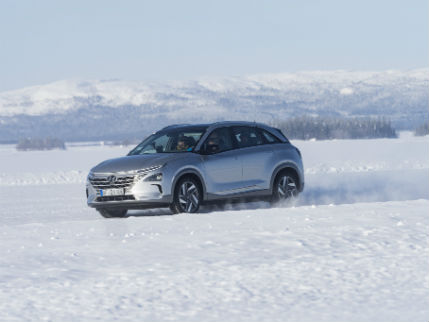#HyundaiMotor Winter Test proves Electrified Vehicles in Swedish Lapland’s Extreme Cold Conditions
Arjeplog: At Hyundai Mobis Proving Ground in Sweden, just an hour’s drive away from the Article Circle, Hyundai Motor Company subjects its latest electrified vehicles to the most extreme sub-zero conditions. Rigorous testing ensures winter-proved operation of Hyundai’s electrified vehicles in temperatures as low as -35°C.
Extreme cold can adversely affect various functions of electrified vehicles, such as the ability to start the vehicle, manage thermal control of the electric powertrain, heating and ventilation and maximize the drive range.
Hyundai’s two prominent electrified vehicles, Hyundai NEXO fuel cell electric vehicle (FCEV) and All-New Kona Electric, spearheaded the Hyundai’s winter test.
The previous generations of FCEV faced a significant technical challenge to be started in temperatures within -10°~-20° C. In order to overcome the technical challenge, the Hyundai engineers designed a new component to heat up the fuel cell stack of the Hyundai NEXO in sub-zero conditions. Thanks to this clever thermal management strategy, the Hyundai NEXO can be started at -30° C, which is on par with any other types of internal combustion engine powered vehicles.
The other technical challenge typically found with FCEVs is ice formation within the fuel cell stack after the vehicle is turned off, as water is the only byproduct of electricity generation through hydrogen. Utilizing a blower system attached to the fuel cell stack, when it is turned off, the Hyundai NEXO removes water before it becomes frozen.
The key objective of the winter test for a battery electric vehicle is to achieve the most efficient usage of electricity. In order to maximize the drive range, the Kona Electric incorporates clever engineering solutions to minimize electricity used for heating, ventilation and air-conditioning (HVAC).
The HVAC technologies highlighted in the Kona Electric are a highly efficient new heat pump, smart air intake control, individual ventilation (for driver only) and a pre-conditioning ventilation system.
The Kona Electric’s heat pump system harnesses wasted heat emitted by electrical components and recycles it to increase the efficiency of the heating and ventilation systems. By minimizing electricity consumption from the battery, the heat pump contributes to the overall driving range of the Kona Electric in winter.
The smart air intake control system featured on the Kona Electric recycles heated air by controlling the amount of air entering and exiting the vehicle. By better controlling the air flow inside the vehicle, the HVAC system is able to heat the cabin more efficiently, thereby minimizing the amount of heating used during winter driving.
The individual ventilation system of the Kona Electric completely shuts off heating and ventilation to the foot-well and dashboard ventilation on the passenger side when driving alone. The system is activated by a ‘driver only’ button on the dashboard.
When plugged in, the pre-conditioning ventilation system allows the Kona Electric to be pre-heated, utilizing electricity from the grid before the car is driven. Customers can schedule to pre-heat or pre-cool the cabin of their vehicles before driving.
At the apex of Hyundai’s eco-friendly vehicle line-up, Hyundai’s first dedicated hydrogen-powered SUV, the Hyundai NEXO boasts the best range within the fuel cell and EV car segments, delivering an estimated 800 km from a single charge (under NEDC testing).
Featuring two different battery capacity options, the long-range version Kona Electric with a 64 kWh battery pack is going to deliver up to 482 km of drive range on a single charge, whilst the basic version with a 39.2 kWh battery pack is going to deliver up to 312 km (under WLTP regulations).

